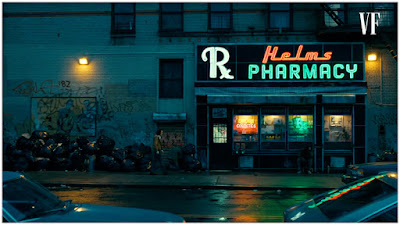
Watching the movie Joker, I felt repeatedly that I was watching a film that Greg Heisler could have lit. The use of color was unique, sophisticated and fearless — almost a character unto itself.
In this outstanding 15-minute short produced by Vanity Fair, Joker cinematographer Lawrence Sher dissects his own use of light and color in the movie.
__________
Please watch this video.
The piece is brilliant—and fully applicable to still photographers' exploration of the use of light and color. As you are watching, here are some key ideas that you'll want to learn to apply to your own lighting.
Single-Axis Black and White
When you are working with black and white, tonality (how bright the area in a photo is) is your only variable which which to create contrast and separation. This simplified structure is exactly why we embrace black and white in Strobist Lighting Workshops. It distills lighting down to a one-axis equation.
Learning to light in black and white is akin to learning the concepts of algebra by beginning with single-variable equations.
Three-Axis Color
The use of light and color, on the other hand, varies along three axes: tone (how bright it is) hue (what color it is) and saturation (how intensely that color is being expressed.)
Hue on its own is really a two-axis variable. There is a warm-cool component, which we think of as color temperature. But there also is a magenta-green component, which we think of as tint.
Magic Hour is Magic
Even with all of the embedded costs involved with managing a full cast and crew on a major motion picture, Sher often is governed by the 20-minute window of magic hour (AKA blue hour) to film outdoor scenes that are bathed in color.
As relatively unencumbered still photographers, our takeaway should be to always pre-plan how you are going to use every blue hour at your disposal when shooting an assignment or a project.
On our X-Peditions trips, this is the one time of day I don't ever want to see you sitting around at the hotel. You have a 20-minute window that ideally you should have preplanned so as to maximize this limited opportunity.
Embrace Dirty Light
Whether shooting outdoors in magic hour or indoors in mixed light, be willing to go with what the light is giving you.
One good way is to look at the scene on daylight (AKA 5600K) white balance. That will give you the camera's view of just how far off from "neutral" the light in the room is.
If you really want to feel that color offset, try underexposing the room a bit on daylight WB, and the colors will appear to get more intense. If you are lighting the room, coincidentally, this is a great way to both saturate your environment and drop its intensity to contrast your soon-to-be artificially lit subject.
Just remember to gel the subject with a color palette that will look appropriate within the color of light in the environment.
Finally, try to learn to resist the urge to "fix" light by neutralizing the color. This is why auto white balance is probably the most soul-sucking setting on your camera. It kills interestingness.
Instead, learn to explore the space between the way your camera sees color and the way your eye sees it.
Tweaking the balance between expressing color the way our cameras see it (clinical and scientific) and the way our eyes see it (partially corrected and psychologically more complex) will give you loads of control over the way your photos ultimately feel.
__________
The Bigger Picture
This color palette from Joker may totally work for you. Or it might not. But if you have seen the film, it is hard to deny how effective the use of color is as a psychological and emotional component of the movie.
Understand that we are strongly affected by the color, intensity, direction and softness of light. And as photographers it is in our best interest to master all of the tools in our box, whether we are merely recording existing light or creating it with our flashes.
__________
This article was published as an entry in Strobist Lighting Cookbook. New articles and how-to's appear monthly. To receive notifications for new posts, you can follow via email or via Instagram.
Strobist https://ift.tt/2r1HaQx
Sourced by Time Trap Photography sharing the best photography tips, news and tricks throughout the industry. Time Trap Photography is dedicated to freezing those special moments in life that can be revisited and admired for generations to come. - Shannon Bourque
Please visit our main site for booking availability and rates.

Receive valuable industry knowledge delivered free to your email each day.













No comments:
Post a Comment
Thank you so much for your comment. A moderator will review and approve all relevant posts. We appreciate your support and encourage you to stay with us by subscribing to our email updates. Where you can easily pick and choose what photography subjects interests you. Subscription link: http://bit.ly/photo-sub